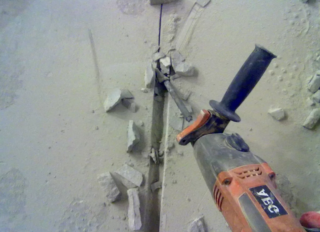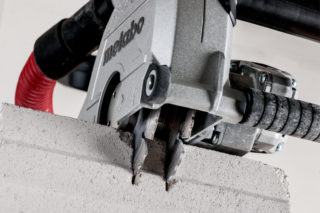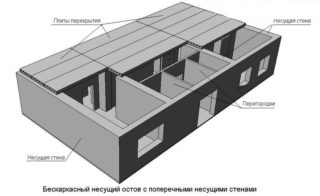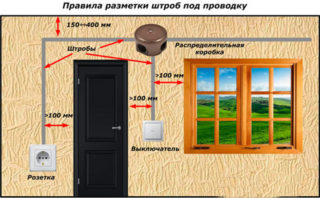When you independently lay various communications in a panel house, the question arises whether it is possible to gouge its walls for electrical wiring, water pipes, sewers and other communications. Despite the high strength of the concrete structures of such buildings, the wrong approach to this operation can lead to negative consequences - the loss of the supporting structures of their original characteristics, the appearance of cracks and various deformations. In case of a very gross violation of the rules for laying communications, chipping can lead to the gradual destruction of panels and floor slabs, which will lead in the future to the collapse of the walls or the entire building.
Bearing walls of a panel house

Supporting vertical structures carry the bulk of the weight of the above floors or roof. Depending on the location, they can have openings for windows, balcony doors.
Load-bearing wall panels consist of the following layers:
- The outer layer is a huge mass of high-strength concrete of the M400 brand evenly covering the reinforcing cage.
- Rebar frame - a mesh that occupies most of the panel's volume and gives it strength and rigidity. As a material for such a frame, reinforcement rods with a diameter of 12-14 mm are used, connected with each other using a special steel flexible and corrosion-resistant wire.
- The protective layer is a thin layer of concrete of the same grade as the outer covering frame made of reinforcement from the inner side of the panel facing the living space. It has a thickness of 10-20 mm and serves to protect the reinforcement cage from damage.
- Internal finishing layer - to be poured using easy-to-process finishing solutions. It has a thickness of 15 to 20 mm and is used for various repairs.
In many modern panels, between the outer layer with reinforcing mesh and the inner finishing layer, there is a layer of insulation - stone or basalt wool.
It is almost impossible to distinguish between finishing and protective layers. Therefore, when chasing, one should be guided by the fact that the inner layer has a thickness of no more than 20 mm.
It is strictly forbidden by the building rules to shtrob the following structures of a panel house:
- ceiling or floor slabs,
- crossbar.
Inside the floor slabs there are already ready-made oblong cavities through which the wiring can be pulled. There is no point in chasing the crossbar, since they will still be covered with decorative trim, under which it will be possible to place electrical wires.
How to identify a load-bearing wall
- facing the street or staircase, into the staircase;
- dividing two adjacent apartments;
- located perpendicular to the floor slabs;
- having a thickness of at least 20 cm, excluding finishing layers of plaster, putty.
All other wall structures are partitions.
When determining the load-bearing walls in an apartment, I also take into account which project this residential building belongs to. Panel houses of the 1-464 series have not only external, but internal load-bearing walls, while the houses of the 1-335 series are characterized only by external panels.
Is it possible to gouge load-bearing walls and ceilings
According to all currently existing rules and building codes, regulations and legislative documents in the field of construction, the laying of strobes in load-bearing walls and interfloor floor slabs with a large number of voids is prohibited.
Theoretically, a homeowner can obtain permission to lay strobes by agreeing on their location, depth with the author of the house project. At the same time, an official conclusion (permission) is issued indicating that the channels laid in the panels will not affect their bearing capacity.
It is forbidden to cut load-bearing walls in a monolithic house for wiring or other communications. The same goes for the ceiling, as it consists of floor slabs. If the wall is not a load-bearing wall, it can be channeled without any restrictions.
Side of the law
When cutting strobes in partitions by third-party specialists hired by the owner, damage to structures will be reimbursed at the expense of the contractors or the employing organization
Wall chipping rates
The main normative document governing the chasing process is SNiP 3.05.06-85. According to it, the channels cut in the wall must meet the following requirements:
- Horizontal grooves should be no more than 25 mm deep, no more than 20 mm wide, and no more than 300 mm long. In this case, the distance from the channel made in the concrete to the floor slab should not be less than 150 mm.
- Vertical grooves, unlike horizontal ones, can be of any size. A few restrictions for them are the observance of the following distances: 100 mm - to window openings and corners, at least 400 mm to gas pipelines.
Also, it is not allowed to lay these channels in concrete structures with damage to the reinforcing cage, embedded ones.
Work technology

Before starting the laying of strobes in the concrete structures of a panel house, using a level, a long aluminum rule, a pencil and a tape measure, marking lines are applied to the concrete base. Hand or electric tools are used to lay strobes in concrete structures of panel houses.
- Hammer and chisel - With the help of a wide chisel and a heavy hammer, the concrete inside the outlined contours of the groove is neatly knocked out.
- Drill and chisel - a large-diameter concrete drill is inserted into the drill, with its help a number of holes are made in the center of the groove contour, after which the concrete is knocked out with a sharp chisel.
- Perforator - a large drill with a tip in the form of a blade is installed in the tool holder, after which the perforator is switched to percussion mode and gradually, in pieces, knocks out the outlined channel.
- Shtroborez - cutting grooves with this specialized tool is performed with two diamond discs with manual adjustment of the distance between them. The concrete is knocked out with a chisel or hammer drill.
You can also chisel through a concrete monolith using a grinder equipped with a diamond-coated disc.
Among the tools, the most convenient and technologically advanced is a chasing cutter - with its help you can cut a channel that is correct in shape and depth for laying the wiring, spending a little time and effort.
Electrical wiring is laid in the made channel, fixed in the wall every 20-25 cm using a solution of alabaster or gypsum. Close up the groove with a cement-sand mortar laid in it, putty or apply a layer of plaster.
Features of laying the wire in the floor slab
To lay the wiring through the cavities inside the floor slabs, it is enough to make two holes at opposite ends of such a channel, and then carefully pull the wire through it.
This laying technology is used only on the floor.
Slitting in partitions
No one can prohibit the cutting of channels for laying wiring in partitions, so it is done without any restrictions. If it is necessary to install a socket on each side of the partition, a through hole is made in the lower part of the channel.
Safety regulations
Before chasing the walls for wiring in a panel house, you need to take care of observing safety rules, protecting the respiratory organs, eyes, skin of the hands from the effects of cement dust and pieces of chipping concrete. You will need:
- protective glasses;
- respirator;
- gloves;
- headphones.
To improve working conditions in between cuts of channels in concrete, the resulting cement dust is removed using a powerful vacuum cleaner, if possible, the room is ventilated.










